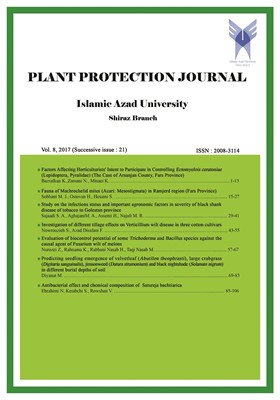-
-
List of Articles
-
Open Access Article
1 - Factors Affecting Horticulturists' Intent to Participate in Controlling Ectomyelois ceratoniae (Lepidoptera, Pyralidae) (The Case of Arsanjan County, Fars Province)
Khadijeh Bazrafkan Naser Zamani Kambiz Minaei -
Open Access Article
2 - Fauna of Machrochelid mites (Acari: Mesostigmata) in Ramjerd region (Fars Province)
Mohammad Javad Sobhani Hadi Ostovan Shahram Hesami -
Open Access Article
3 - Study on the infections status and important agronomic factors in severity of black shank disease of tobacco in Golestan province
seyyed afshin sajjadi Mohammad Ali Aghajani Hoda Assemi Mohammad Reza Najafi -
Open Access Article
4 - Investigation of different tillage effects on Verticillium wilt disease in three cotton cultivars
Shahram Nowrouzieh Fatemeh Azad Disfani -
Open Access Article
5 - Evaluation of biocontrol potential of some Trichoderma and Bacillus species against the causal agent of Fusarium wilt of melons
Zaynolabedin Nurozei Kamran Rahnama Hojjatollah Rabbani nasab Misam Taqinasab -
Open Access Article
6 - Predicting seedling emergence of velvetleaf (Abutilon theophrasti), large crabgrass (Digitaria sanguinalis), jimsonweed (Daturastramonium) and black nightshade (Solanum nigrum) in different burial depths of soil
Marjan Diyanat -
Open Access Article
7 - Antibacterial effect and chemical composition of Satureja bachtiarica
Nikta Ebrahimi Saghar Ketabchi Vahid Rowshan
-
The rights to this website are owned by the Raimag Press Management System.
Copyright © 2021-2025







